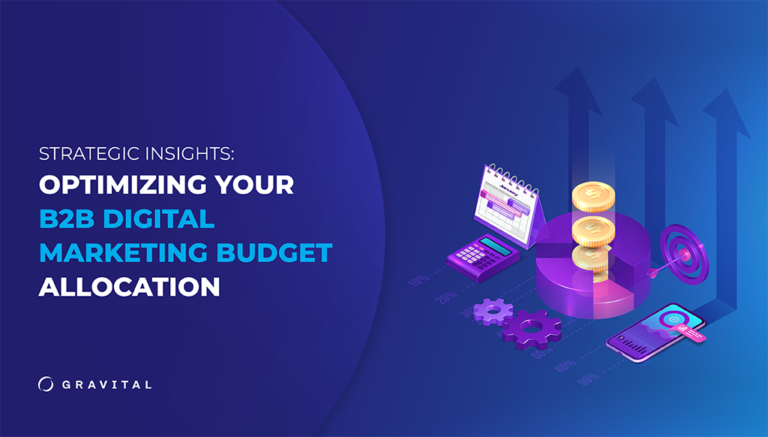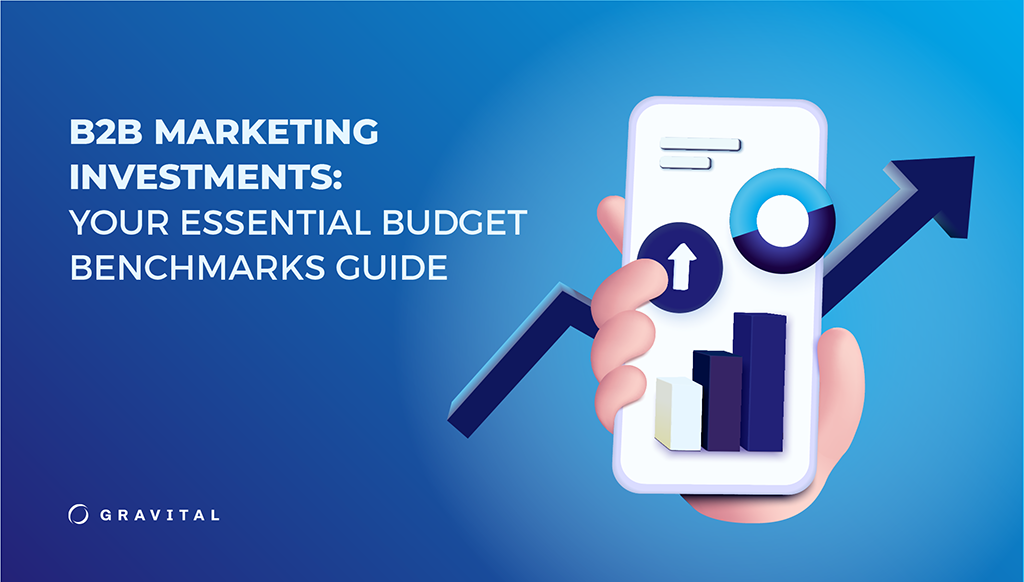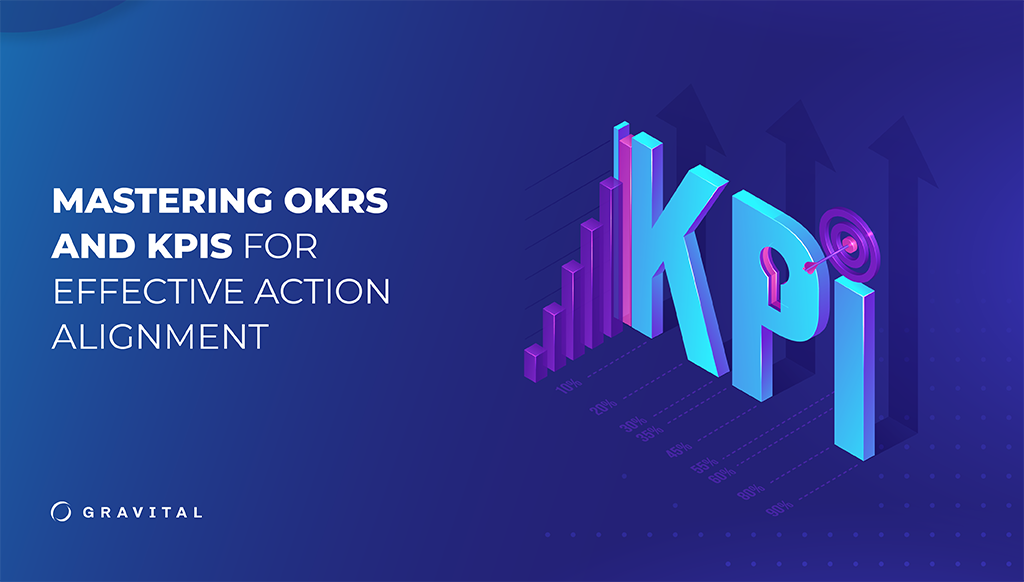In the dynamic realm of digital marketing, B2B companies face a constant struggle: maximizing return on investment (ROI) while juggling limited budgets with multiple digital marketing tools and channels. It’s a tough balancing act.
To harness the potential of digital marketing, B2B companies need to be strategic about budget allocation.
Budget Allocation in Digital Marketing
Budget allocation in digital marketing is the strategic distribution of financial resources across various channels and tactics to achieve the desired marketing goals.
It’s not just about deciding how much to spend but also about maximizing the effectiveness of every dollar invested. Think of it like investing in a portfolio, but instead of stocks, you’re investing in digital marketing assets such as content marketing, search engine optimization (SEO), paid advertising, social media, email marketing and other digital channels.
Understanding your audience’s digital habitat and aligning your budget accordingly is key. B2B brands typically invest more in tactics that lead to long-term lead generation, such as content marketing and SEO. But strategic budget allocation calls for diversifying that portfolio.
Suppose your B2B company specializes in software solutions for the healthcare industry. You have a budget of $50,000 for the year and your goal is to generate 1,000 qualified leads. Here’s how budget allocation might play out:
- Content marketing: 20%. Allocate $10,000 to create high-quality blog posts, eBooks, whitepapers and webinars targeting specific pain points in the healthcare sector.
- SEO: 15%. Invest $7,500 in optimizing your website content and backlinks to improve organic search visibility.
- Paid advertising: 35%. Dedicate $17,500 to targeted Google Ads and LinkedIn campaigns to reach decision-makers in hospitals and clinics.
- Social media marketing: 15%. Invest $7,500 in engaging content and targeted ads on relevant platforms, such as LinkedIn, X (formerly Twitter) and Facebook, to build brand awareness and generate leads.
- Marketing automation: 15%. Set aside $7,500 for implementing a marketing automation platform to nurture leads and streamline your campaigns.
READ ALSO: THE IMPORTANCE OF IMPLEMENTING STORYTELLING IN YOUR SOCIAL MEDIA DIGITAL MARKETING STRATEGY
Precision Pays: Why Strategic Allocation Matters
The consequences of haphazard budget allocation are as numerous as they are painful. Scattered investments lead to diluted impact, campaigns struggling to gain traction and, ultimately, ROI evaporating like morning mist. Conversely, a meticulous strategy delivers several highly coveted benefits:
- Maximized ROI: Proper allocation channels your marketing funds into strategies that offer the most value and highest ROI.
- Strategic alignment: It ensures that spending aligns with your overall business goals and marketing objectives, driving tangible results such as qualified leads and brand awareness.
- Optimized resources: It allows for efficient use of resources, eliminating redundancies and avoiding overspending in one area while neglecting another.
- Enhanced agility: It makes you better equipped to adapt to emerging trends and capitalize on new opportunities.
- Data-driven decisions: Precise metrics inform budget adjustments, allowing you to pivot and optimize campaigns in real-time.
For instance, if lead generation is your primary goal, you might consider allocating more budget to pay-per-click (PPC) campaigns and LinkedIn marketing.


Allocating Your B2B Digital Marketing Budget
1. Find Your North Star
Begin by defining what you want to achieve with your digital marketing efforts. Is it brand awareness, lead generation, website traffic, customer retention? Then set SMART goals–specific, measurable, achievable, relevant and time-bound–and allocate your budget in line with these objectives.
2. Know Your Audience
Understanding your target audience is absolutely critical. Immerse yourself in their digital world. What platforms do they frequent? What content resonates with them? Research their online behavior. Identify the channels where they’re most active and that, therefore, have the highest conversion potential, and allocate more funds to these channels.
3. Evaluate Past Performance
Look at your previous marketing campaigns. What worked? What didn’t? Identify which channels delivered the most bang for your buck, and which were mere embers. Use these insights to inform your budget allocation decisions.
4. Benchmark Wisely
Industry averages offer valuable context, but avoid mindless mirroring. Your unique audience and goals should be the primary compass guiding your allocation.
5. Leverage Data-Driven Insights
Regularly track campaign performance metrics such as conversion rates and cost per lead to identify high-performing channels and areas for improvement. Use these insights to allocate more budget to the channels with the best performance metrics, fine-tune your budget allocation throughout the year, and improve your ROI.
6. Test and Adapt
Digital marketing is dynamic. Be prepared to test new strategies and reallocate your budget based on what delivers the best results. For example, if you allocate 20% of your budget to PPC and realize it brings in the most leads, consider increasing this percentage.
7. Embrace Flexibility
Markets can change rapidly. Ensure your budget allocation is flexible enough to adapt to unforeseen changes or opportunities. Be prepared to adjust your budget throughout the year.
READ ALSO: HOW TO GENERATE B2B OPPORTUNITIES BY CREATING SUCCESSFUL MARKETING EVENTS
8. Monitor Industry Trends
Stay informed about the latest B2B marketing trends. For instance, if video marketing is gaining traction in your industry, consider allocating funds for it.
9. Invest in Technology
Use marketing automation tools to streamline campaign management, optimize lead nurturing and gain valuable insights into your audience’s behavior.
10. Balance Between Paid and Organic Strategies
While paid advertising can offer quick results, organic strategies like SEO and content marketing provide long-term benefits. A balance between the two can be cost-effective.


Allocating your B2B digital marketing budget is not a set-it-and-forget-it task. It’s an ongoing process that requires continuous evaluation and adaptation. By following the tips above, you can create, develop and manage B2B digital marketing efforts that are both effective and efficient.
If you would like more information about digital marketing budget allocation or could use some help with your B2B digital marketing strategy, talk to us.


